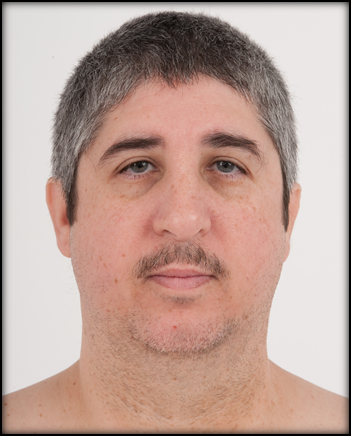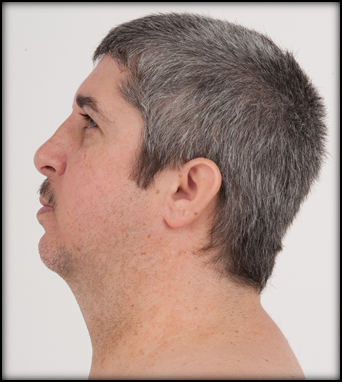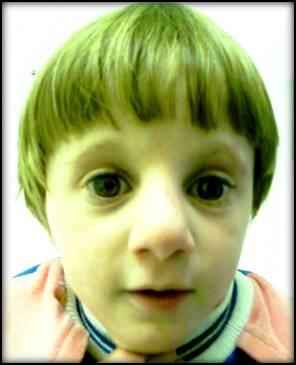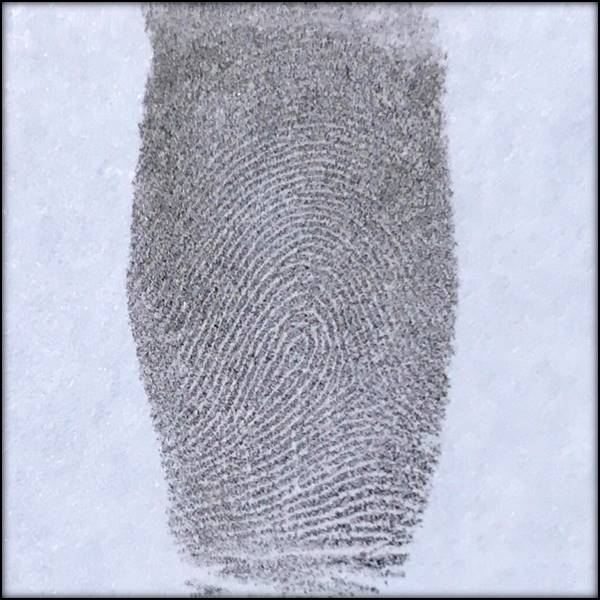Dubowitz syndrome (DS)
Dubowitz syndrome (DS) is an inherited syndrome that causes a variety of medical and other problems. Some, such as small size, are obvious at birth, while others appear later (see next section for details). DS affects males and females equally. It has been reported in many different parts of the world, including North America (including patients from Mexico), South America, Europe, and western and eastern Asia (1). Although there are no estimates for how frequently it occurs, it is very rare.
Clinical information
DS affects many body systems. Its characteristic features are poor growth before birth, short stature, a small head (microcephaly), a characteristic face, intellectual disability, and eczema in infancy/early childhood (this problem may improve by early school-age). These features and other very common ones are listed below:
- Eczema or eczema-like skin rash (early years especially)
- High-pitched nasal voice (may also be hoarse)
- Very short stature (often <3rd percentile)
- Poor weight gain in the early years
- Microcephaly (very small head)
- Intellectual disability (low IQ)
- Delayed speech development
- Hyperactive behavior
- Low birthweight
- Shy personality
- Flat feet
Common clinical features of DS
Many people with DS also have a sacral dimple, which is an indentation in the skin over the buttocks (see painting at bottom of page; 2, 3). Sacral dimples are generally harmless.
Another harmless skin pattern that seems to be common in DS is a type of fingerprint called an ulnar loop (see photo at bottom of page; 2, 4-6). Ulnar loops are loops in the center of the fingerprint; when viewed on the fingers, the rounded part of the loop points toward the thumb (see photo below for explanation). Some patients have them on 7 or more fingers (2, 5). Many have them on 3 or more digits.
People with DS tend to be hyperactive but shy (1). Other behavioral problems may include aggressiveness, inability to concentrate, and sleep disturbances. A recent review suggested that patients be assessed with the Vineland Adaptive Behavior Scales as a way of assessing behavior, and the Differential Ability Scales, which can help create an education plan for a patient (1).
In addition to the clinical features listed above, many people with DS have similar facial features. The most common ones are listed below. These features may not be present in every patient, and they may become less obvious with time (see photos on this page).
- Triangular-shaped face (with chin as bottom point; see photo of girl)
- Epicanthal folds (skin covering the inner corners of eyelids)
- Flat brow ridges (bone directly over eyes is smooth)
- Receding/underdeveloped jaw
- Ptosis (droopy upper eyelid)
- Sparse or absent eyebrows
- Sparse or thin head hair
- Malformed ears
- Low-set ears
- Wide-set eyes
Facial features of DS
Cause
The cause of DS is not known. Evidence points toward an autosomal recessive disorder. This term means that the disorder is passed on when both parents contribute a copy of a mutated gene to their child. One recent study associated the gene NSUN2 with a syndrome that DS-like (8), but mutations in this genes must to be found in other DS patients before it can be confirmed as a cause of DS.
One recent study associated the gene NSUN2 with a syndrome that DS-like (8), but mutations in this genes must to be found in other DS patients before it can be confirmed as a cause of DS.
Another study found mutations in the gene LIG4 in the man whose photos are on this page (7). The mutations were also found in his sister. These indiviuals had been diagnosed with DS in the early 1970s and had been followed for many years. A third patient in the same study had a mutation in chromosome 17, but the gene was not idenfied (LIG4 is on chromosome 13). Because two different genes were mutated in these three people, the study authors noted that what is currently called DS may actually be a group of related disorders. This question will not be answered without more research.
Diagnosis
Unfortunately, there are no specific lab tests for DS. Diagnosis is therefore clinical, or based on signs and symptoms. The lack of tests is due in part to the fact that no gene is associated with DS. In addition, no biomarkers unique to DS have been found. The fact that DS resembles other diseases makes diagnosis difficult and often a matter of ruling out other conditions.
A combination of features can point to DS. They include the facial features noted above, along with sparse eyebrow and/or head hair, small size at birth/intrauterine growth retardation, short stature, eczema or an eczema-like rash in the early years, and a high-pitched/hoarse voice (9). In addition, the presence of multiple ulnar loops along with other signs of DS may help.
Differential Diagnosis
The differential diagnosis for DS includes a number of other disorders. Because there are no definitive lab tests for DS, diagnosis can become a process of elimination. If DS is suspected, a consulation with a clinician who has seen other DS patients may be very helpful. It is important to remember that the facial features of DS may not be obvious in a given patient, and that they may become less obvious with time.
Fetal alcohol syndrome (FAS). The clinical features of FAS are very similar to those of DS. For example, small stature, small head size, low IQ, delayed speech development, and hyperactive behavior are common in both syndromes. The most important way to distinguish them is to determine the extent of alcohol consumption during pregnancy.
Fanconia anemia (FA). FA and DS share a small number of distinctive features, including short stature, cancer, heart problems, and a triangular face. Notably, some people with DS and FA have a small head size/microcephaly and a normal IQ, and/or a small head and normal development during infancy. A low IQ is far more common in DS than FA (~75% of DS patients compared to ~25% of DS patients). However, some DS patients have normal intelligence and microcephaly, and the combination should not be used to rule out DS.
Some problems that are common in FA are rare or not generally present in DS. They include pancytopenia (low counts of red and white blood cells and platelets) and thumb abnormalities (missing or duplicated thumbs, for example). Genetic testing can diagnose FA.
References
- 1. Huber RS et al. (2011) Dubowitz syndrome: a review and implications for cognitive, behavioral, and psychological features. J Clin Med Res 3(4):147-155. Full text on PubMed.
- 2. Majewski F et al. (1975) A rare type of low birthweight dwarfism: the Dubowitz syndrome. Z Kinderheilkd 120(4):283-292. Abstract on PubMed.
- 3. Küster W & Majewski F (1986) The Dubowitz syndrome. Eur J Pediatr 144(6):574-578. Abstract on PubMed.
- 4. Opitz JM et al. (1973) Studies of malformation syndromes of man XXIV B: the Dubowitz syndrome. Further observations. Z Kinderheilkd 116(1):1-12. Abstract on PubMed.
- 5. Orrison WW et al. (1980) The Dubowitz syndrome: further observations. Am J Med Genet 7(2):155-170. Abstract on PubMed.
- 6. Wilroy RS et al. (1978) The Dubowitz syndrome. Am J Med Genet 2(3):275-284. Abstract on PubMed.
- 7. Stewart DR et al. (2014) Dubowitz Syndrome is a complex comprised of multiple, genetically distinct and phenotypically overlapping disorders. PLoS ONE 9(6):e98686. https://doi.org/10.1371/journal.pone.0098686. Full text on PubMed.
- 8. Martinez FJ et al. (2012) Whole exome sequencing identifies a splicing mutation in NSUN2 as a cause of a Dubowitz-like syndrome. J Med Genet 48(6):380-385. Full text on PubMed.
- 9. Pascual JC et al. (2005) What syndrome is this? Dubowitz syndrome. Pediatr Dermatol 22(5):2480-481. Abstract on PubMed.
- 10. Chehade C et al. (2013) Dubowitz syndrome: common findings and peculiar urine odor. Appl Clin Genet 6:87-90. doi: 10.2147/TACG.S47777. Full text on PubMed.
- 11. Courbet G (1853). The Bathers. Wikimedia Commons. Public domain reproduction.





